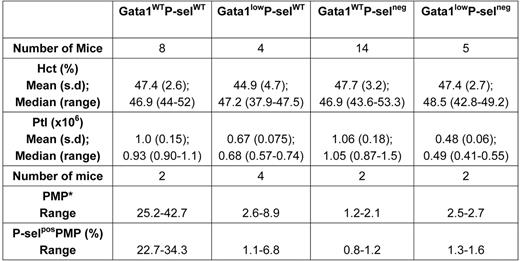Abstract
Abstract 1907
Poster Board I-930
Primary myelofibrosis (PMF) is characterized by abnormalities of megakaryocyte maturation, bone marrow fibrosis, increased angiogenesis, bone formation and extramedullary hematopoiesis. Patients are often anemic and thrombocytopenic and, as patients with other myeloproliferative disorders, have increased risk for bleeding and thrombosis. It is debated whether propensity to thrombosis is due to increased numbers of platelet microparticles (PMP) and/or to pathological platelet-neutrophil interactions. The megakaryocytes of these patients, in fact, express normal levels of P-selectin (P-sel, an adhesion receptor that mediates interaction with neutrophils) that remains abnormally localized to the demarcation membrane system (DMS) rather than being assembled into the a-granules. Mice carrying the hypomorphic Gata1low mutation (deletion of the regulatory sequences that drive Gata1 expression in megakaryocytes) express the same megakaryocyte abnormalities presented by PMF patients, including abnormal P-sel localization to the DMS and develop with age myelofibrosis, a disease that closely resembles PMF. Whether these mice would also develop thrombosis has not been investigated as yet. The aim of this study was to determine whether Gata1low mice would develop thrombosis with age and, in this case, the role played by P-sel in the development of the trait. To this aim, Gata1low mice were crossed with P-selnull mice (kindly provided by dr. P. Frenette) according to standard genetic protocols and Gata1lowP-selWT, Gata1lowP-selnull and Gata1WTP-selnull or Gata1WTP-selWT (as controls) littermates obtained. The hematocrit (Hct), blood platelet counts (ptl) and PMP counts were compared among the four experimental groups (Table 1).
Hct, ptl and PMP in the blood of mice carrying the Gata1low and/or P-selnull mutation.

PMP were defined by FACS as anti-CD61pos events against the events of constant numbers of microbeads added to platelet poor plasma produced by serial centrifugation steps as calibrators.
There were no significant differences among the four groups of mice with respect of Hct (Kruskal-Wallis nonparametric analysis of variance, 2-sided p=0.89) although there were differences among these groups with respect to platelet levels (Kruskal-Wallis 2-sided, p= 0.002). In particular, Gata1WT mice had significantly greater platelet levels than Gata1low mice regardless of P-sel (Wilcoxon rank test, p ≤0.0001, no adjustment for multiple comparisons). PMP were found to be reduced in Gata1low mice compared to Gata1WT littermates (Table I). Gata1WTP-selnull and Gata1low/P-selnull littermates had also reduced numbers of PMP. P-sel was only expressed by PMP from Gata1WTP-selWT mice. On the other hand, not only adult and old Gata1lowP-selWT mice but also Gata1WT/P-selnull and Gata1low/P-selnull littermates had bleeding times longer (<600 sec) than those observed with Gata1WT/P-selWT mice (181±69 sec). Ethical limitations in bleeding time estimates prevented assessment of eventual differences between the bleeding times of mice carrying the different mutations. The presence of thrombosis in heart and kidney of mice carrying the different mutations was determined according to standard histological criteria. In these experiments, mice were divided into young (2 months), adult (5-9 months) and old (10-16 months) age group (n=3 in each group). No thrombosis was found in Gata1WTP-selWT, Gata1WT/P-selnull or Gata1low/P-selnull mice of any age group or in young Gata1lowP-selWT mice. However, in adult and old Gata1lowP-selWT mice thrombosis was found in 50% of the organs investigated. The majority of the thrombi were found in adult mice (67% vs 33% of organs affected).
Therefore, the maturation defect induced in megakaryocytes by the Gata1low mutation leads to a pro-thrombotic state detectable from 5 months of age. The presence of the P-selnull mutation rescues the thrombotic phenotype but not the ptl, PMP or bleeding time deficiency induced by the Gata1low mutation. Thus, abnormal P-sel localization to the DMS, rather then altered PMP numbers, appears to be responsible for the thrombogenicity induced by the Gata1low mutation. These results suggest P-sel as possible target for therapeutic prevention of thrombosis in PMF.
No relevant conflicts of interest to declare.
Author notes
Asterisk with author names denotes non-ASH members.

This feature is available to Subscribers Only
Sign In or Create an Account Close Modal